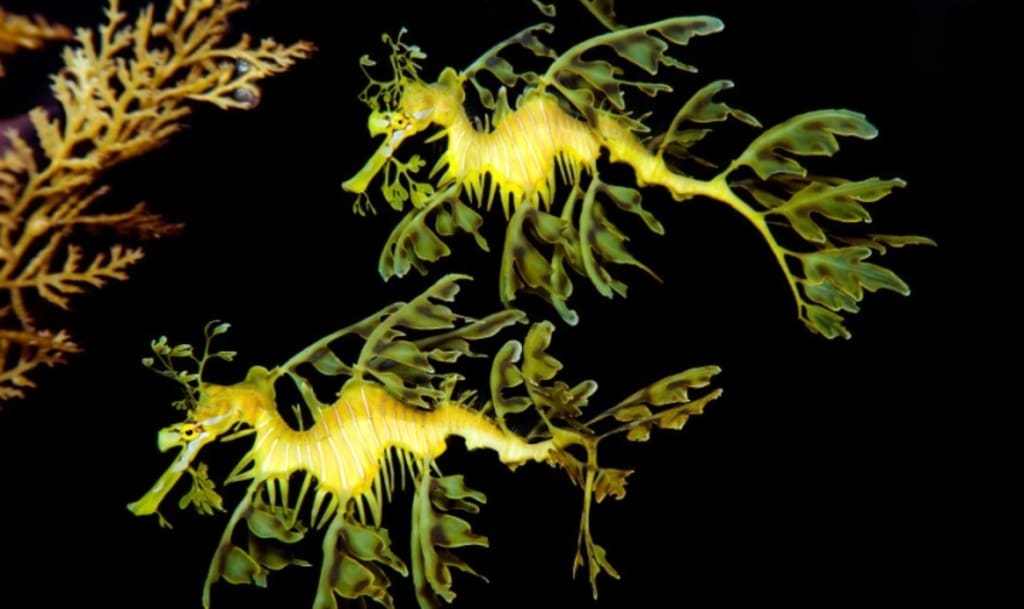
In the depths of our planet's oceans, a remarkable array of creatures exists, each uniquely adapted to its environment. These enigmatic beings, often concealed from the human eye, reveal nature's ingenious solutions for survival, evolution's artistic experimentation, and the interconnectedness of life on Earth. Let's embark on a journey to discover some of these exceptional aquatic and terrestrial marvels.
The Leafy Sea Dragon: Nature's Master of Camouflage
Nature has a way of crafting astonishing adaptations, and the leafy sea dragon stands as a testament to its mastery. As close relatives of seahorses, these enigmatic marine creatures have honed their camouflage techniques to perfection. Their exquisite appendages, resembling the delicate fronds of seaweed and kelp, serve as the ultimate disguise, allowing them to seamlessly merge with their underwater habitat. It's a spectacle of invisibility, a true marvel that captivates those fortunate enough to witness it.
What makes the leafy sea dragon even more extraordinary is its fluid and almost ethereal movement. These magnificent beings utilize two nearly invisible fins, located discreetly near their chest and back, to glide gracefully through the watery realms they call home. It's a ballet of stealth, an art form that demonstrates nature's ingenious solutions for survival.
But this remarkable disguise and graceful dance are just the beginning of the leafy sea dragon's story, a creature that showcases nature's boundless creativity in the depths of our oceans.

The African Burrowing Frog: Master of Underground Survival
Originating from the southern coast of Africa, the African burrowing frog has evolved exceptional survival tactics. These frogs are natural architects, creating complex tunnel systems that delve as deep as 15 centimeters beneath the ground's surface. When faced with danger, they demonstrate a unique defense mechanism by inflating their bodies, making them appear larger and deterring potential threats.

The Orchid Mantis: Nature's Deceptive Predator
The orchid mantis, a native of the tropical rainforests of Southeast Asia, stands out as a remarkable example of evolutionary adaptation. Found across regions ranging from Indonesia and the Philippines to India, these insects exhibit a wide range of colors, with white, pink, or yellow being the most common. However, it's the females of the species that truly captivate attention with their petal-like limbs, resembling the beautiful orchid blooms. Scientific research suggests that this unique appearance has evolved as a deceptive hunting strategy, enabling them to capture larger prey, such as butterflies.

The Pygmy Mouse: A Tiny Wonder of Southeast Asia
Nestled within the heart of Southeast Asia, the pygmy mouse emerges as a true testament to the marvels of the animal kingdom. In the realm of hoofed creatures, this minuscule wonder reigns supreme. Weighing a mere fraction of their larger relatives, these diminutive beings tip the scales at just under 1 kg, showcasing the immense diversity of nature's creations.
Residing in secluded, pristine landscapes, far removed from the hustle and bustle of urban life, the pygmy mouse has carved its niche. What sets them apart in this wilderness are their petite fangs, a distinguishing feature among the pantheon of small mammals that inhabit the region. Yet, this modest description is just the tip of the iceberg, as we delve deeper into the captivating world of the pygmy mouse.

The Naked Mole Rat: The Long-Living Royalty of the Underground Realm
The East African naked mole rat, more commonly known as the "naked mole rat," is a testament to the wonders of underground life. With a remarkable lifespan of up to 32 years, these subterranean dwellers outlive their rodent counterparts by a factor of nine. Their complex society boasts a matriarchal structure, with designated individuals responsible for reproduction duties. These intriguing rodents offer a glimpse into the fascinating world beneath the earth's surface, where longevity, social order, and unique features come together in a captivating narrative of life in the depths.






Comments (1)
Test is not accepting comments at the moment
Want to show your support? Send them a one-off tip.